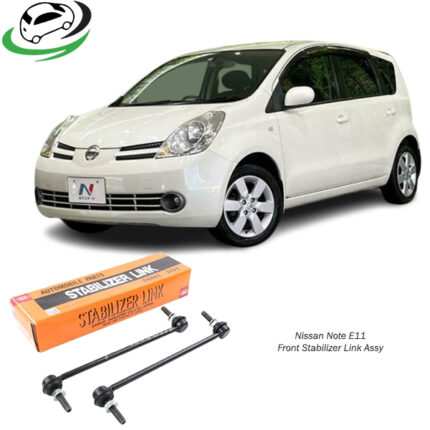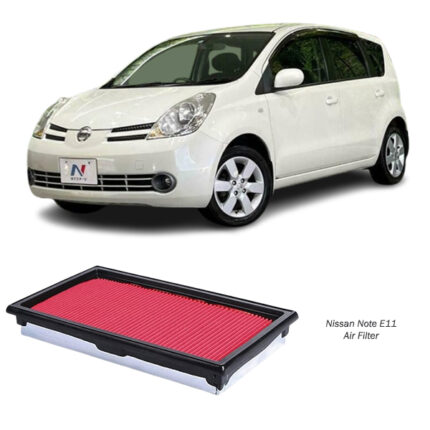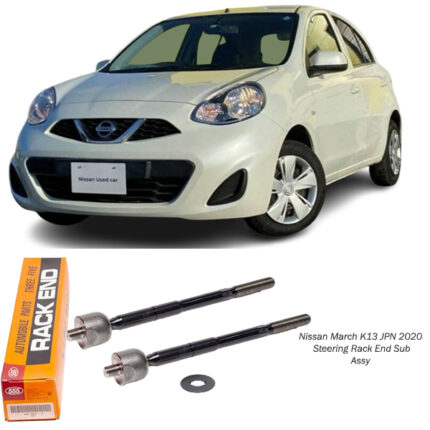Get Nissan March K13 JPN 2020 Steering Rack End Assy SR-N330 in Kenya
The steering rack end assembly is an integral part of a vehicle’s steering system, serving as the bridge between the steering rack and the outer tie rods. This component ensures smooth and precise communication of the driver’s inputs to the wheels, enabling safe and accurate steering. Its role in maintaining stability, alignment, and handling cannot be overstated. This comprehensive guide delves into the functions, components, benefits, potential issues, and maintenance tips for the steering rack end assembly.
Functions of the Steering Rack End Assembly
- Steering Input Transmission
The primary function of the steering rack end assembly is to transfer rotational motion from the steering rack to the tie rods, which in turn move the wheels. This enables the vehicle to respond effectively to the driver’s commands. - Flexibility in Motion
The assembly allows for the vertical and horizontal movement of the suspension system, ensuring that the steering system accommodates road irregularities without compromising control. - Maintaining Wheel Alignment
Working in conjunction with the tie rods, the rack end assembly ensures that the wheels remain properly aligned, which is essential for efficient handling and vehicle stability. - Shock Absorption
The rack end assembly absorbs and mitigates the effects of road vibrations and impacts, preventing these forces from being transmitted to the steering wheel.
Components of the Steering Rack End Assembly
The steering rack end assembly comprises several interconnected parts, each contributing to its functionality:
- Inner Tie Rod
The inner tie rod connects the steering rack to the outer tie rod and is responsible for transferring motion. - Ball Socket or Ball Joint
This component allows for pivoting motion, enabling flexibility in steering and suspension articulation. - Threaded Shaft
The threaded section of the inner tie rod provides the connection point for the outer tie rod, facilitating precise adjustments during alignment. - Protective Dust Boot
The rubber or synthetic boot shields the rack end assembly from contaminants such as dirt, moisture, and debris, prolonging its service life. - Retaining Clips or Fasteners
These secure the dust boot and other components in place, ensuring the assembly’s integrity during operation.
Benefits of a Steering Rack End Assembly
- Enhanced Steering Precision
A well-maintained rack end assembly ensures that the driver’s inputs are accurately translated into wheel movement, improving vehicle handling and responsiveness. - Improved Safety
Properly functioning rack ends contribute to stable wheel alignment and consistent steering performance, reducing the risk of accidents. - Reduced Wear on Tires
By maintaining proper wheel alignment, the assembly minimizes uneven tire wear, extending the lifespan of the tires and lowering replacement costs. - Comfortable Driving Experience
The rack end assembly dampens road vibrations, offering a smoother and quieter ride for both the driver and passengers. - Longevity of Steering Components
By absorbing shocks and distributing forces evenly, the assembly reduces the wear and tear on other steering components, such as the rack and tie rods.
Common Issues with Steering Rack End Assemblies
- Wear and Tear
Continuous use and exposure to road conditions can cause the ball joint or socket to wear out, leading to loose steering or instability. - Boot Damage
The protective dust boot may crack or tear over time, allowing contaminants to enter and accelerate wear on the internal components. - Misalignment
A worn or damaged rack end can lead to improper wheel alignment, resulting in uneven tire wear and steering difficulties. - Noises While Steering
A faulty rack end assembly may produce clunking or knocking noises when the vehicle encounters bumps or during sharp turns. - Excessive Steering Play
A loose or failing inner tie rod can result in excessive play in the steering wheel, reducing precision and control.
Signs of a Failing Steering Rack End Assembly
- Steering Instability
Wandering or pulling to one side while driving could indicate a failing rack end. - Clunking or Knocking Sounds
Unusual noises from the front suspension or steering system are often a sign of worn components in the rack end assembly. - Uneven Tire Wear
Visible wear patterns on the front tires, such as excessive wear on the inner or outer edges, could point to misalignment caused by a damaged rack end. - Difficulty Steering
Increased effort required to turn the steering wheel may indicate issues with the rack end or other steering components. - Vibrations in the Steering Wheel
Vibrations or shakiness in the steering wheel, especially during acceleration or at higher speeds, may be linked to a faulty rack end assembly.
Maintenance Tips for Steering Rack End Assemblies
- Regular Inspections
Periodically check the rack end assembly for signs of wear, damage, or corrosion. Include the protective boot in the inspection to ensure it remains intact. - Timely Replacement
Replace the rack end assembly at the first sign of wear or damage to prevent further steering or suspension issues. - Wheel Alignment After Replacement
Always perform a wheel alignment after replacing the rack end to ensure optimal vehicle handling and tire wear. - Lubrication
If applicable, ensure that the ball joint or socket is adequately lubricated to minimize friction and prevent premature wear. - Avoid Harsh Driving Conditions
Driving carefully over potholes, speed bumps, and rough terrain can prolong the lifespan of the rack end assembly by reducing exposure to excessive forces. - Professional Maintenance
Have the steering system inspected by a professional mechanic during routine maintenance to identify and address potential issues early.
Replacement Process for Steering Rack End Assembly
Replacing the rack end assembly involves specific tools and expertise. The general steps are:
- Lift the Vehicle
Use a jack and jack stands to safely elevate the vehicle for access to the steering components. - Remove the Wheel
Take off the wheel to expose the tie rod and rack end assembly. - Detach the Outer Tie Rod
Remove the retaining nut and disconnect the outer tie rod from the rack end. - Remove the Dust Boot
Slide off the protective boot to access the inner tie rod. - Unscrew the Rack End Assembly
Use a tie rod removal tool to unscrew the rack end from the steering rack. - Install the New Rack End
Secure the new rack end in place, ensuring it is tightened to the manufacturer’s specifications. - Reattach Components
Replace the dust boot, reconnect the outer tie rod, and reassemble the wheel. - Perform Wheel Alignment
A professional alignment is necessary to restore proper handling and ensure even tire wear.
Conclusion
The steering rack end assembly is a vital component in a vehicle’s steering system, ensuring smooth, precise, and safe handling. Its role in transmitting steering inputs, maintaining alignment, and absorbing road shocks makes it indispensable for modern vehicles. By understanding its functions, benefits, and maintenance requirements, drivers and mechanics can ensure optimal performance and longevity. Regular inspections, timely replacements, and proper handling are key to keeping the rack end assembly in excellent condition, contributing to a safer and more enjoyable driving experience.
Follow us on Facebook for more parts.




